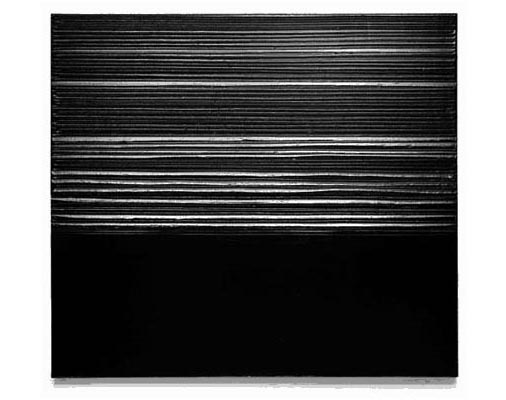
I have always loved the color black—much to the dismay of my family and friends, who were convinced it signaled some deep psychological issue. (A teenager dressed entirely in black? Suspicious, indeed.) But I adored the color then, and I still do. These days, my all-black wardrobe raises fewer eyebrows.
When I was younger, I never cared what others thought about my monochrome outfits or the supposed meaning behind them. To me, black was the source of everything. Then, unexpectedly, someone affirmed my belief that black was not just a color like any other—but perhaps something more. That person was Pierre Soulages, the French abstract artist known as “the painter of black.”
It was in the late ’80s when I first saw one of his paintings on television. It was a diptych, and the way the light reflected off the striated black surface transformed it into something luminous, almost radiant. As Soulages himself put it:
“When light is reflected on black, it transforms and transmutes it. It opens up a mental field all of its own.”
So true.
Since then, bolstered by Soulages’ work and his words, I have embraced black as a beautiful, powerful color. The World of Sama that I created—existing solely in black and white—needed no pinks, reds, or blues. For years, I carried that moment with me, the realization that black can be bright, that black is luminous. Yet, until recently, I had never experienced Soulages’ “transformation and transmutation” in person.
That changed with the large-scale retrospective at the Pompidou Centre in Paris, celebrating the work of France’s greatest living painter. Ending on March 8, it was an exhibition I simply couldn’t miss. After nearly two decades, I could finally witness with my own eyes what had shaped my creative vision so profoundly. People often ask me what inspires me—Soulages is undeniably a major part of the answer.
The retrospective gathers over a hundred significant works, from the striking walnut-stain paintings of the late ’40s to more recent pieces, many displayed for the first time. I was eager to immerse myself in his work, especially after years of hearing dismissive comments from those who had never even seen it. “Black is black. There’s nothing more to it.” Or, “There’s International Klein Blue, and then there’s Soulages’ black paintings. They’re just colors.”
As if it were only about color.
Soulages’ work is about perception—about texture, depth, and above all, light. The striations in his black surfaces alter the way light interacts with them, making black shift, evolve, and transform depending on the viewer’s perspective. It’s not just about black paint; it’s about the interplay of matte and glossy textures, the way he coaxes luminosity from darkness. His work truly transcends black—it is Outrenoir (Beyond Black).
Standing before his monumental panels, diptychs, and polyptychs was an immersive experience. I could feel the color—vibrant, shifting, alive. Though his paintings are untitled, they are dated, and my favorites include 02/08/1992, 03/19/1979, 03/17/2000, 04/22/2002, 02/24/2008, 05/22/2002, and 01/17/2009. This retrospective transported me back 20 years to my first encounter with his work. For two hours, I moved from piece to piece, studying the light on every surface, observing, absorbing, and rediscovering the many dimensions of this so-called “non-color.”
It was a profound experience because black has shaped both my life and my art since I was a teenager. Black has always inspired me, and no one has ever revealed its depths as masterfully as Soulages.
The exhibition is expected to travel to the U.S., allowing more people the chance to witness this extraordinary work. I encourage you to experience it for yourself. I could talk about Soulages and his art for hours, but instead, I’ll leave you with a statement from the artist himself—one that beautifully answers the question I am so often asked:
‘Why black? The only answer, which covers the unknown reasons that lurk in the obscurest regions of ourselves and to the powers of painting, is: BECAUSE’. –Pierre Soulages, 1986.
Visit Pierre Soulages’ Website: http://www.pierre-soulages.com/
